Final report for FW17-015
Project Information
Grafting apple trees onto specific rootstocks for size control, early bearing, and pest and disease resistance has been practiced for hundreds of years. This practice was formalized in Europe during the 1800s with the selection of distinct rootstock cultivars. By the 1970s and 80s apple rootstock development peaked with research programs in new regions including Russia and the United States (notably the Cornell/USDA research station in Geneva, NY). Despite this, the diversity of rootstocks today remains extremely limited. A review of nurseries typically reveals readily available sources only of the Geneva selections, the Malling (England) rootstocks, or the Russian BUD rootstocks. This represents rootstocks selected at only three locations, optimized for three climates, three soil types, and common production challenges found in three regions. While good efforts have been made to evaluate the adaptability of rootstocks beyond the research stations where they were selected, screening usually takes place where the apple industry is already established (and where previous Geneva, Malling, and Russian rootstocks were already successful). This does little to expand the range of rootstock options for new regions and new climates. The result is that aspiring apple growers are often forced to artificially re-create optimal growing conditions for the rootstocks available to them. Irrigation systems, drain tile, even the placement of apple trees on elevated beds are just a few of the common ways producers modify their land to sustain non-locally adapted rootstocks. We believe this approach is flawed. Rather than altering land and water to meet the needs of a crop, an agro-ecological approach should foster crops that are adapted to local conditions. Our project proposes to develop exactly such an option for the maritime Pacific Northwest. Six species in the Malus genus are native to North America. In the West this includes Malus fusca (the Pacific crabapple), a species that is abundant in maritime climates extending from Alaska to Northern California. Unique among apple species, Malus fusca exhibits a wide-range of adaptability to common maritime site conditions: thriving in hydric and wetland soils (including saltwater estuaries), as well as in heavy clay soils, and poorly drained upland sites. It is considered a keystone native species in both high rainfall climates such as coastal mountain rainforests, and in lowland rainshadow environments such as the Puget Sound ‘banana belt’ where local rainfall averages may total less than 20 inches annually. Periodically amateur pomologists and backyard orchardists in the Northwest have dabbled with the use of Malus fusca as a rootstock for table apple varieties. Anecdotally, these novelty grafts have been largely successful, apparently thriving even in conditions where traditional apple rootstocks do not, such as wet meadows. Unfortunately there is no actual research demonstrating how widely compatible Malus fusca is with various apple varieties. Through this project we will establish a research block of Malus fusca rootstocks, testing at least 40 high value apple varieties for grafting compatibility over a three-year period. By successfully demonstrating high levels of grafting compatibility with multiple apple varieties, this project has the potential to: Provide significant new economic opportunities for farmers in western California, Oregon, Washington, and Alaska by offering a viable apple rootstock for wet and poorly drained locations – in many of these regions urbanization has consumed the best agricultural lands, squeezing farmers onto poorly drained and other sub-optimal lands; Eliminate the need to drain wet farm fields for crop production – a goal aligned with USDA conservation programs; Encourage greater adoption of perennial agriculture and the associated benefits to carbon sequestration and soil and water conservation; Provide a fully fire blight-resistant rootstock – Malus fusca has documented polygenic resistance to fire blight; Foster a more ‘native’ and ecologically appropriate crop system, potentially supporting native soil biodiversity; Support more localized apple production near major cities such as San Francisco, Portland, Seattle, and Juneau. The research component of this project will be conducted at our farm located on Washington’s Whidbey Island, the center of Malus fusca’s native range, and will be supported by a robust educational program that includes an ongoing project blog on our farm website, the development of a conference poster and workshop session, and a bulletin summarizing project results distributed in partnership with Washington State University Extension. These outreach resources will be promoted through farm and apple industry media. This project is led by farmer and ecologist Eric Lee-Mäder. Eric holds a masters degree from the University of Minnesota Department of Horticulture where he studied commercial fruit production and tree nursery management. His professional background includes previous work as a beekeeper, an Extension educator, and crop consultant to the native plant nursery industry. He currently co-directs the Xerces Society’s Pollinator Conservation Program (www.xerces.org) where he works with farmers, companies, and government agencies to enhance biodiversity in agricultural lands. Eric is the author of several books including the best-selling Attracting Native Pollinators, and Farming with Beneficial Insects. Through his current position at Xerces, Eric has collaborated on multiple highly successful SARE projects in all four SARE regions, impacting tens-of-thousands of acres and reaching thousands of farmers and agency professionals. This project is supported by technical advisor Dr. Carol Miles of Washington State University. Dr. Miles currently leads research and extension in cider apple production in Western Washington, including orchard establishment economics, apple variety trials, and cider quality evaluation. Along with grafting and horticulture-related technical support, Dr. Miles will assist with the dissemination of project findings.
Activities for this project include: Year 1. 1. January – December 2017: Launch a project blog on our farm website and perform regular updates (www.NorthwestMeadowscapes.com). To develop a blog audience we will create a press release for distribution to farm and apple industry media. Additionally we will conduct a survey via the blog to capture basic audience information and interests. 2. January – February 2017: Pre-order bare root Malus fusca seedlings from supplier native plant nurseries.
3. February – September 2017: Prepare the research plot, including a) removal of two dead trees, b) mowing and herbicide treatments to remove weedy vegetation, c) re-seeding with a permanent orchard cover crop (e.g. meadow barley and other site-adapted native grasses), and d) clean-up the old field road to the research site. 4. June – August 2017: Protect the research plot by installing deer fencing prior to planting. Year 2.
1. January – February 2018: Collect scion wood from apple industry contacts, commercial sources, and research station orchards. Note that we will test at least 40 scion varieties (10 replicates of each) with an emphasis on varieties in high demand by Seattle and Portland markets. These include cider varieties such as Wickson, Dabinett, Bedan, Binet Rouge, and Amere de Berthencourt, as well as heirloom table apples, such as Spitzenberg and Ashmead’s Kernel (based upon scion wood availability). 2. March – April 2018: Conduct bench grafting and planting of seedlings. 3. April – September 2018: Manage trees for establishment success, including the installation of rodent-guards. 4. May – October 2018: Perform monthly evaluations of grafting success, recording percent success by variety. 5. January – December 2018: Post regular blog updates, and conduct a second annual blog survey to assess audience engagement. Year 3. 1. April – October 2019: Perform monthly evaluations of grafting success, recording results by variety.
2. January – December 2019: Post regular blog updates. Additionally we will post a project summary at the end of the year, along with a final survey to capture producer adoption and interest.
3. November – December 2019: Develop a poster, workshop abstract, and bulletin documenting the compatibility of various scion varieties. The first of these two products will be submitted as conference proposals at major West Coast farm conferences including the 2019 Washington Tilth Alliance conference, Oregon’s Organicology and California’s EcoFarm conference. The bulletin will be available as a free download on our website and distributed at conferences. Additionally, the bulletin and findings will be promoted through a press release to farm and apple industry media. Beyond the end of SARE funding, we will continue to assess additional traits of Malus fusca as a rootstock, including suckering, graft union strength, and growth rates. Those results will continue to be publicly shared.
Cooperators
- - Technical Advisor (Researcher)
Research
To evaluate the grafting compatibility of Malus fusca rootstocks with the domestic apple (Malus pumila) we are conducting replicated grafting trials of 40 to 46 apple varieties (with 10 replicates of each variety). Those varieties include high demand cider apples provided by the Washington State University Northwest Research and Extension Center in Mount Vernon, Washington: Amere de Berthcourt, Blanc Mollet, De Bouteville, Brown Snout, Brown Thorn, Bulmer’s Norman, Cimetiere, Court Pendu Rose, Dabinett, Domaines, Frequin Rouge, Jouveaux, Medaille D’Or, Mettais, Michelin, Muscadet de Dieppe, Muscat de Bernay, Peau de Vache, Reine des Pommes, Vilberie, and Zabergau Reinette.
Additionally, as of the January 2018 reporting we are expecting a second batch of scion varieties from Dr. Thomas Chao, at the USDA's Apple Genetic Resources Collection at Cornell University, consisting of: Sangre de Toro, Raxao, Blanquina, Teorica, Xuanina, Vedialona, Coloradona, Solarina, De la Riega, Collaos, Perico, Maria Elena, Reineta do Caravia, Repinaldo do Liebana, Pepa, Peil de Sapa, Bedan des Parts, Manchurian, Wickson, Binet Rouge, Calville Blanc, Nehou, Dolgo, Kerry Pippin, and Irish Peach.
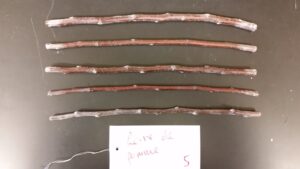
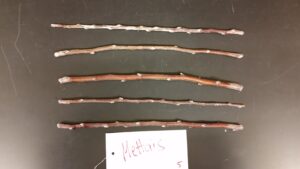
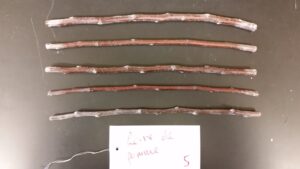
Note that in the original proposal we had targeted only 40 varieties for grafting trails, but we have sought out six additional varieties as a back-up against grafting errors to ensure that we still meet the original project target. Additionally, we had originally planned on only 400 total grafts, but the rootstock nursery offered us a significant price break for 500 rootstocks (actually making that amount less expensive than 400) so we ordered 500 rootstocks which again will help mitigate any grafting errors and ensure that we meet the original project targets.
The Malus fusca rootstocks consist of seed-grown plants produced by a local native plant container nursery. They are 3-year transplants, having previously been harvested as bare root plants in 2016, and replanted in the field during 2017, before being re-dug in the fall. The result of this transplanting is larger caliper plants with well-developed root systems and an overall height of 18 to 36 inches. While the scion wood is being harvested and moved into cold storage at the time of the January 2018 reporting, the rootstocks are not scheduled for delivery from the nursery until March 2018. We will be contacting the nursery in an attempt to negotiate earlier delivery so that winter grafting can commence as soon as possible. Because of our region’s temperate winter climate planting can begin in mid to late winter.
Additional planting materials have been ordered and are anticipated for delivery in late January or early February 2018.
Once grafted and field planted, we will conduct monthly evaluations of grafting success over the livespan of this project, noting percent grafting success by variety to document the tolerance of various apple varieties to Malus fusca as a rootstock. Note that we have deliberately focused this project on antique and heirloom apple varieties (including heirloom cider varieties) since these offer a clear niche market opportunity for small-, midsized-, and new apple producers. Given the large-scale of establish commercial apple production, it seemed unlikely that popular dessert apple varieties such as Honeycrisp could offer an economical business opportunity for new apple producers on a new, still largely untested rootstock that is not yet widely available from commercial rootstock producers.
Our planned layout for test orchard consists of 50-foot long rows of trees, with 4-foot spacing between them and 12-foot wide alleys. We settled upon this layout after consulting with several sources, including Washington State University’s cider apple production specialists. If the majority of the grafts survive, this layout would be compatible with a hedge-style of production in which the trees are sheared with a sicklebar or hedge clipper in the spring to both maintain row configuration and to thin the apple crop. Additionally, this orchard style anticipates advancements in mechanical harvesting technology including trunk shaking and ground harvesting methods which may become more commonplace in the future.
As of December 2017, most of the new orchard block preparation has been conducted, including site clearing with a brush hog, removal of several dead trees, and clearing of the field road to the research site.
January 2019 Update: As 2018 commenced, we began a project year of big challenges, some interesting initial findings, and new questions.
Among the first unanticipated challenges we faced with was simply the toughness of Malus fusca wood. While the wood (and scions) of domestic apple varieties are soft and cut easily with a grafting knife, M. fusca is incredibly hard and challenging to cut, especially those rootstocks of thicker caliper. Grafting required constant knife sharpening, a lot of pressure, and dozens more hours than we had originally budgeted for the task. While most scion cuts could be performed in a few seconds, the rootstock cutting was a persistent bottleneck. We ended up with a number of injuries from rootstock cuts, but more critically, we had to divert a significant amount of time away from regular farm work to complete the grafting.
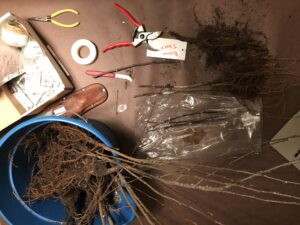
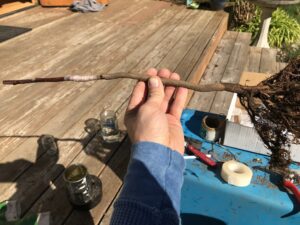
The second unexpected challenge was an extreme abundance and extreme shortage of water. In the first case, we faced a difficult surprise in the spring prior to planting when a neighbor’s water line burst and flooded our orchard area, making it impossible to get into the field. While we waited for conditions to dry out, the newly grafted trees remained heeled-in to a nursery bed. As conditions warmed, the trees began to leaf out, before we could transplant them. When we were able to get into our field, the weather turned unseasonably hot and the trees exhibited clear signs of heat-related transplant shock (wilting). Unfortunately, despite the early season excess of water, the summer remained warmer than average (up to 10 degrees warmer than average for extended periods) and significantly drier than normal. For context, our farm normally averages 22 inches of rain per year (we are located in a mountain rain shadow). During 2018, by our measure, the farm received less than 20 inches of rain.
To help mitigate transplant shock and drought stress, we spent many unexpected durations of time focused on maintaining irrigation water on the trees, even as other farm work went unfinished. Disappointingly we occasionally would water the new orchard block for hours, only to dig down into the soil and still find parched dry conditions just an inch below the surface. As the summer continued, we completely wore down several plow blades on the farm in unusually dry soil, and thirsty rabbits repeatedly chewed through the irrigation lines in search of water.
Because of the dry conditions, we think that heat and water stress certainly had an impact on tree survival. Yet, overall, we are grateful that despite the many hours of unplanned work, the extra watering certainly kept many trees alive. We are hoping that future seasons will see a return to more typical precipitation.
In grafting the trees, we used standard whip/tongue graft unions, wrapped tightly in Parafilm, and held tightly with rubber bands. The tips of the scions were coated in wax to reduce desiccation. Of the scions, we were typically able to cut them down into 4 to 5 sections for grafting onto rootstocks. Because we had 2 to 3 scions for most varieties, we were able to graft 8 to 15 trees for most varieties. One observation about many of the European varieties we used (especially many French cider varieties) is that they tend to have more “blind wood” than some common dessert apple varieties. By this we mean that the spacing between buds tends to be a bit longer, allowing for fewer graft sections to be cut from a single length of scion. In general, we tried to maintain 2 to 4 buds on each scion section we grafted onto a rootstock.
In planting the trees, we supported each transplant with a 48-inch bamboo stake, and protected them with Blue-X brand tree guards consisting of a firm translucent blue plastic film that is rolled into a tube and secured with an outer plastic bag sleeve. While the cost of tree guards was reasonable (allowing them to be deployed on a large scale), the plastic does tear and photodegrade slightly faster than advertised. Because we are adjacent to expansive natural areas and the ocean, we are vigilant about the fate of plastic used on our farm. It has been a minor annoyance to find bits of broken tree guard and to have to constantly pick up and dispose of small shards.
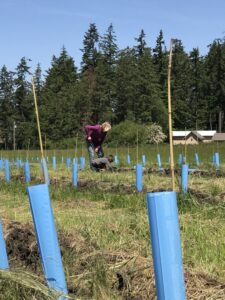
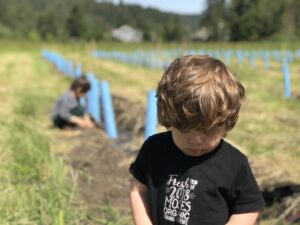
More disappointing however, the tree guards are bird killers. On multiple instances, when removing the guards to inspect trees (which are still small enough to be completely below the top of the tree guards), we have found dead grassland songbirds which, having perched on the bamboo stakes, appear to fall into the tubes where they are unable to spread their wings and fly out. This is unacceptable to us, and we will be working on some kind of barrier for the tops of the tubes to prevent any further bird casualties before the 2019 nesting season commences. We are certain that other growers must face the same dilemma with these kinds of plastic tree guards and are disappointed that manufacturers have not engineered a solution to this problem.
It is worth noting that despite the drawbacks of plastic tree guards, they have been enormously valuable in protecting the transplants from rodents. In a few cases where wind blew some of the tree guards off, the transplants were immediately gnawed on by meadow voles and rabbits (even when the tree guard was only off for a mere day or two). This damage occurs even with very robust raptor and coyote populations on the farm. In the future, we plan on alley cropping between the orchard rows, which may change the rodent pressure for better or worse. In any case, at least on wild crabapples, rodent pressure seems to dissipate as the trees mature in size and develop thicker trunks and basal bark. In observing mature crabapples on the farm there does not appear to be any rodent damage to the trunks which will allow us to dispense with plastic tree guards. That said, if cost and labor were more competitive, we would rather be using metal hardware cloth tree guards than the plastic ones currently in use.
UPDATE – JANUARY 2020
During our 2019 season we had several significant developments in our project materials and methods:
First, we experimented with a variety of methods to improve tree guard performance, particularly to prevent songbirds from becoming trapped and dying inside the tubes. These efforts included experimenting with screened tops (which were hard to secure, with growing trees pushing them off), as well as zip-ties to partially close off the top (which turned out to be time consuming and expensive). Ultimately, we found an elegant solution in simply adding a second bamboo stake, opposite the first one, to hold up the tree guard. This solution turned out to be simple, cheap, quick to install, and a big improvement. With only one stake holding up the tree guard, the wind tended to occasionally blow them off. Two stakes prevent this, and the two stakes (positioned about 4 inches apart) are too close together for birds flapping birds to land between them, which keeps them from landing on the top rim of the guard tubes.
Second, with an eye toward continuing this project and incorporating the lessons-learned, we planted additional un-grafted rootstocks into the orchard that we will graft in future years, comparing the performance of bench grafted trees with field-grafted ones. A new working hypothesis resulting from this initial project is that as wetland-adapted plants, Malus fusca does not tolerated any significant root drying, such as occurs with normal bench grafting.
Third, we added one additional scion variety to the grafting trials in 2019, consisting of Ashmead’s kernel. In the case of grafting this variety, we tried to maintain the rootstocks in buckets of water as much as possible until they were transplanted into the field.
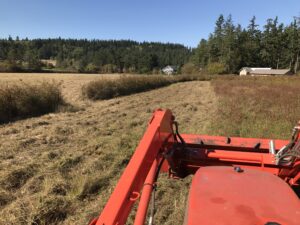
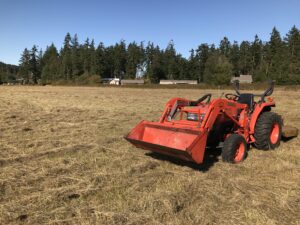
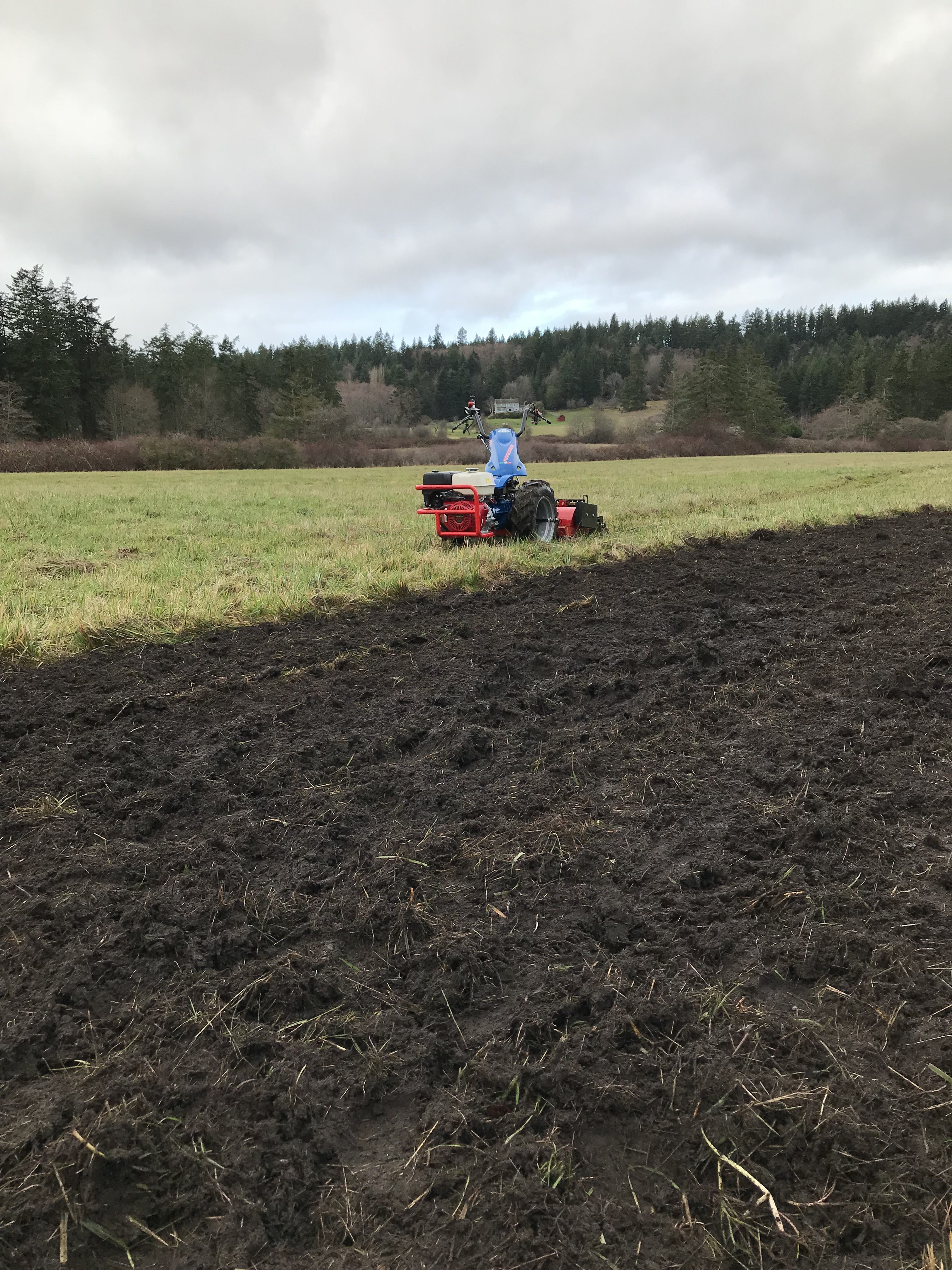
As of December 2017, we have made exceptionally good progress on this project. The site preparation has proceeded largely on course with our original plans, scion wood and rootstocks have been secured for grafting which is beginning in early 2018.
One significant and unexpected challenge during summer 2017 was an ongoing period of unexpected tractor breakdowns during the preparation of the new orchard site. The thick, rank vegetation over-extended the tractor and brush hog capacity and more than doubled the amount of time we planned to spend preparing the site. Additionally, large quantities of dust from the brush hogging clogged the tractor’s air intake causing overheating and requiring us to disassemble and clean various engine parts.
Later stages of the site preparation in Fall 2017 proceeded more easily, with us switching to a small, but very reliable two-wheel walk behind tractor for some additional mowing with a sicklebar and cultivation to prepare rows for planting.
One site preparation activity that is behind schedule is the construction of the deer fence. This task was delayed due to new deer fence design options that we discovered during summer 2017 through conversations with other local farmers. Ultimately we have been weighing the pros and cons of two different options and are narrowing down our decision as of January 2018. Fortunately, when we plant, our new trees will be immediately protected with grow tubes so we have a small window of additional time before the trees leaf out of the tubes and become susceptible to deer damage.
January 2019 Update: In late 2018, we conducted our first survey of grafting success. The following list (in descending order) represents grafting success rates for each variety:
- *Bulmer’s Norman: 90%
- *Domaines: 88%
- *Frequin Rouge: 88%
- *Vilibrie: 88%
- *Dabinette: 86%
- *Blanquina: 80%
- *Brown Snout: 78%
- Normannischen Ciderbirne: 75%
- *Sangre de Toro: 75%
- *Nehou: 75%
- *Amere de Berthencourt: 72%
- De la Riega: 66%
- Butt Pear: 66%
- *Muscat de Bernay: 63%
- *Zabereau Reinette: 60%
- Barland Pear: 60%
- *Reine des Pommes: 60%
- Thorn Pear: 60%
- Cimitere: 56%
- Raxao: 50%
- Kerry Pippin: 50%
- Pepa: 50%
- Rieneta do Caravia: 50%
- Collaos: 50%
- Wickson Crab: 33%
- Repinaldo do Liebana: 25%
- Calville Blanc: 25%
- Teorica: 25%
- Perico: 25%
- Hendre Huffcap Pear: 22%
- Coloradano: 20%
- Manchurian Crab: 17%
- Barnet Pear: 16%
- Yellow Huffcap Pear: 14%
- Blanc Mollet: 14%
- Muscadet de Dieppe: 10%
- Irish Peach: 0%
- Binet Rouge: 0%
- Maria Elena: 0%
- Solarina: 0%
- Dolgo Crab: 0%
- Red Pear 0%
- Old Field Pear: 0%
- Taynton Squash Pear: 0%
Note that in this list, the asterisk (*) denotes varieties that had extremely vigorous scion growth. These include Bulmer’s Norman, Muscat De Bernay, Reine De Pomme, Sangre De Toro, Nehous, Domaines, Zabereau Reinette, Blanquina, Frequin Rouge, Vilibrie, Amere De Berthencourt, and Dabinette. In the case of these varieties, not only were the majority of the grafts successful, but the scions also often put on more than 12 inches of growth.

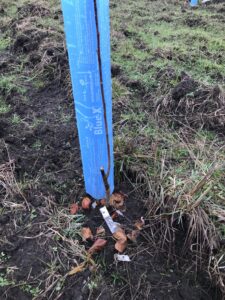
It should also be noted that we were not able to evaluate twelve of the varieties we grafted due to early dormancy and leaf drop. These include De Bouteville, Brown Thorn, Court Pendu Rose, Jouveaux, Medaille D’Or, Mettais, Michelin, Peau de Vache, Xuanina, Vedialona, Peil de Sapa, Bedan des Parts. We will resume observations on these in the spring to assess grafting success.
In reviewing the success rates to date, several trends are emerging, and new questions are occurring. First, it should be noted that to assess the full varietal compatibility of Malus fusca, we added several pear varieties to our trial. With only three exceptions (Barland, Butt, and Thorn pears) the success rates with pear grafts were lower than with apples. Historically Malus fusca was classified as Pyrus fusca (the same genus as pears), and anecdotal conversations with other orchardists in the region have claimed that pear grafts can work on the rootstock as well as apple. So far, our current findings suggest that some pear varieties may initially work, but in our case, more than 50% of the pear varieties we trialed had low or no rates of success.
Similarly, but more surprising we had very low success with two Asiatic crabapples (Dolgo and Manchurian). We expected that, being other Pacific rim species, these two varieties would be compatible with our rootstock. That theory does not seem to be supported by our initial findings.
Of the varieties, we have been able to evaluate this year, 52% demonstrated good success (grafting success of 50% or higher). We think however that this number is lower than the true grafting compatibility of this rootstock for several reasons.
First, because of the wild nature of the rootstock, there was considerable variation in size and root development among the rootstocks we received from the nursery that produced them for us. In some cases, the bare root plants from the nursery had significantly reduced or pruned root systems (lacking any fine root hairs). While these plants are probably capable of surviving when planted in a habitat restoration or reforestation project, they may not have had enough rootsystem to support a grafted scion, and the callus formation around the graft. In fact, in the case of grafts that failed, approximately 2/3rds of the rootstocks are still alive and producing new suckers.
Second, the extremely dry summer certainly impacted tree survival, tree vigor, and added additional stress to the graft healing process. As a general (but not absolute) trend, the varieties with lower success rates tended to be on located on the edge of the orchard block farthest from our well, where irrigation water pressure is slightly lower.
With these possibilities in mind, we are planning additional grafting attempts in the year ahead, using new suckers from the surviving rootstocks, and grafting directly onto them in the field once they are of sufficient diameter. Additionally, we have a small order of additional rootstocks being delivered from our native plant nursery that we will graft with one additional variety, Ashmead’s Kernal.
UPDATE – JANUARY 2020
Based now on two years of observations, we can report the following results:
- Approximately 1/3 of the rootstocks failed. We now think this is likely due to poor root structure and excessive root pruning (due to variable bare root quality of nursery stock), and due to a poor tolerance on the part of the Pacific crab for root disturbance and drying.
- Overall, Pacific crab produced successful grafts with 86% of the scion varieties.
- Varieties with a greater than 70% grafting success rate included: Bulmer’s Norman, Domaines, Frequin Rouge, Vilibrie, Dabinette, Blanquina, Bedan des Parts, Brown Snout, Ashmead’s Kernal, Normannischen Ciderbirne, Sangre de Toro, Nehou, Brown Thorn, and Amere de Berthencourt.
- Varieties with a greater than 50 to 70% grafting success rate included: De la Riega, Butt Pear, Muscat de Bernay, Zabereau Reinette, Barland Pear, Reine des Pommes, Thorn Pear, Cimitere, Raxao, Kerry Pippin, Pepa, Rieneta do Caravia, and Collaos.
- Varieties with a less than 50% grafting success rate included: Wickson Crab, Repinaldo do Liebana, Calville Blanc, Teorica, Perico, Court Pendu Rose, Medaille D’Or, Peil de Sapa, Hendre Huffcap Pear, Michelin, Coloradano, Manchurian Crab, Barnet Pear, Vedialona, Yellow Huffcap Pear, Peau de Vache, Blanc Mollet, Muscadet de Dieppe, Xuanina, De Bouteville, Mettais, and Jouveaux.
- Varieties with no grafting success rate included: Irish Peach, Binet Rouge, Maria Elena, Solarina, Dolgo Crab, Red Pear, Old Field Pear, and Taynton Squash Pear.
Based upon our observations, we now think Pacific crab is probably compatible as a rootstock for most apple and pear varieties.
We think that our limited success (or failures) with some varieties in this trial is a factor of:
- Too fewer replicates of some varieties (due to not enough scion wood);
- Variable rootstock quality, in which some varieties were grafted onto rootstock batches of lower quality;
Water-stressed rootstocks undergoing transplant shock (as a wetland-adapted plant, Pacific crab simply may not always perform well as a bare-root plant for bench grafting).
Research Outcomes
Education and Outreach
Participation Summary:
As of the first project reporting period we have had a very successful start to our education and outreach efforts. In summer 2017 we began developing the basic web site for our project blog (located at: https://northwestmeadowscapes.com/pages/pacific-crabapple-project), and in October, following the conclusion of major site work, we began developing and posting regular updates to the project blog.
Once we were satisfied with the blog appearance, formatting, and functionality, we immediately developed and distributed a project press release for distribution within the apple industry, with copies sent to various trade magazines such as Good Fruit, Fruit Growers News, Just Picked, Cider Craft, Modern Farmer, Acres USA, and Mother Earth News. Following on this press release, Just Picked, the journal of the Organic Fruit Growers Association ran a small article highlighting the project (https://docs.wixstatic.com/ugd/2c6509_966c8b7fe896495897a5519ba4107fb4.pdf).
Additionally, to further promote the project and the project blog, we have worked to highlight it on social media, including the Facebook page of the North American Fruit Explorers Association (NAFEX), as well as on our own farm Facebook page (https://www.facebook.com/northwestmeadowscapes).
Reviewing analytics provided by Facebook, our project post reached 114 people. Interesting, only 67 people follow our farm’s Facebook page, meaning the project overview was shared with 47 additional people beyond our ongoing followers. Moreover, a review of our blog analytics shows 72 unique individual visitors. While the precision of those numbers is not always perfect (for example our website analytics may not be distinguishing between human and robot visitors), it does suggest at least some active human audience for the project.
This audience has been further confirmed by an ongoing email inquiry from a Canadian farmer located near us (on an adjacent island in Puget Sound, located in Canadian waters). That farmer was specifically seeking out solutions to apple production on a poorly drained site and was very interested in the potential of using Malus fusca rootstock. Moreover, that farmer has been interested in comparing notes on scion varieties that are suitable for our local growing conditions (some varieties are locally very susceptible to apple anthracnose). Through an on-going conversation we have been learning more from them about what varieties seem to have anthracnose resistance as well as sharing some variety information with them that they were not previously aware of.
Only one task with our education and outreach plan is behind schedule which is the development of a reader poll for our blog to better understand audience interests, attitudes, and change in practices based upon this project. Progress on the poll fell behind schedule due to a much more intensive and time consuming site preparation process than we anticipated which took time away from this part of our outreach plan. As soon as planting is complete in early 2018, we will re-prioritize this task.
Over the next year we will continue to highlight project progress on our blog and if there are significant initial findings we will communicate them in a follow-up press release. Looking ahead in Year 3, project results will be summarized in a poster and submitted to several key farm conferences for poster and workshop sessions.
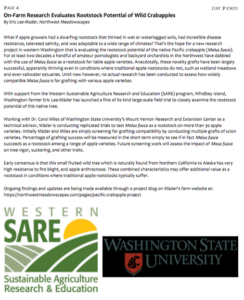
As of early 2019, it is clear that the extensive focus on simply keeping vulnerable stage trees alive over the past growing season has limited our capacity to provide extensive blog updates. That said, there has been limited initial findings to report during this first season, and we have been able to add some new blog content. Interestingly, the project blog is the 7th most visited page on our farm business website (among several dozen individual pages). During the past year, the blog attracted 184 distinct visitors, who spent 233 reading sessions on the webpage. This represents roughly 3 times more visitors than the previous year. While it is not possible to distinguish between human and robot web traffic, it does suggest an increasing human audience. Moreover, our blog is the top Google search result for “Malus fusca rootstock,” which should help ensure that people scouring the internet for information on this use of this species will find our project and be able to learn from our findings.
As further confirmation of our farmer impact, we had two additional farmer contacts during the 2018 reporting period. One of those contacts was a new orchardist in Western Washington who was in the planning stages of tree planting and faced with poorly drained site conditions. That orchardist has since gone on to establish a formal business, and is in the process of orchard establishment, working with not only with the Pacific crabapple, but a variety of other experimental rootstocks, including quince.
The second new contact was a farmer in British Columbia and director of the British Columbia Fruit Testers Association. That farmer had previous experience grafting with Malus fusca, including some grafts that are now 5 years old. That farmer was able to report good success with a number of dessert varieties including King, Suntan, Honeycrisp, Gala, and Melrose. They expressed appreciation of our project and were grateful to see more information on the types of results other growers were getting in using this rootstock.
Beyond farmers, we were invited to share the project concept and initial findings with several apple breeders and rootstock researchers, as well as to have the project highlighted in an academic symposium. In April 2018, the project PI (Eric Lee-Mäder) travelled to the Minnesota and shared the project with Drs. Emily Hoover and Jim Luby at the University of Minnesota.
Dr. Hoover is a participating investigator on a nationwide joint university research project (The NC-140 Rootstock Research Trial) that is seeking to identify and test new apple rootstocks with improved traits. Dr. Luby is one of the breeders responsible for developing the Honeycrisp apple. Following this meeting, Eric gave a presentation to the University of Minnesota Department of Horticulture, as part of the Horticulture Science Outreach Day that briefly highlighted the early stage of the project. More than 100 researchers, graduate students, and members of the public attended the presentation.
UPDATE – JANUARY 2020
We had a relatively good outreach impact in our final project year:
- First, although we submitted several proposals to regional farm conferences, we were unable to secure a dedicated speaking opportunity focused specifically on this project alone. However, we were able to incorporate slides about the project, and to include a brief summary within several larger farm biodiversity talks.
- The first of these was within a farm biodiversity workshop we conducted at the Tilth Alliance Conference in Yakima, Washington on November 9, 2019 for an audience of approximately 70 people. After, the session, we were approached by two apple growers who were interested in more details of the project, which allowed us to share our project summary bulletin.
- The second opportunity to share the same slides was at a Xerces Society and Pierce County Conservation District workshop on November 19th at the WSU Extension and Research Center in Puyallup, WA for 66 people (including farmers conservation agency staff, and master gardeners) during a session on the use of native plants on farms.
- Over the past year we have further started to network with the agroforestry community. At an October farm conference in the Midwest we were able to meet with a staff person from the Savannah Institute, a Wisconsin-based agroforestry non-profit focused on applied research and technology transfer, and we discovered the Association for Temperate Agroforestry (AFTA), an organization based at the University of Missouri’s Center for Agroforestry. We’re exploring the potential for engaging with both of these organizations around our project, including a possible article submission to the AFTA newsletter.
- Finally, we developed a summary project poster that we can use in future outreach (several of the farm conferences we explored this past year did not offer poster sessions), and we developed a 4-page project summary bulletin that can be emailed or printed. To capture basic information about the kinds of farmers who might be interested in our project, we have made the bulletin available on our website after readers fill out a survey, answering the following required questions: Are you currently a farmer, and if so, what do you grow, and on what scale? Do you have any experience with Malus fusca? Has reading any of this encouraged you to do any of your own experimental grafting?
Northwest Meadowscapes Pacific Crab Bulletin
FINAL UPDATE – DECEMBER 2020
In our final project year we were able to include a brief discussion of using Malus fusca as a nativ e apple rootstock in a November 13th webinar (in a discussion of native plants uses on farms) sponsored by the Jefferson County and Kitsap County Conservation Districts in Washington State. The total audience for the webinar consisted of more than 200 participants.
Education and Outreach Outcomes
Reflecting on the first year of this project, we have made good progress the majority of tasks and remain on track to complete the project on time and on budget.
One major challenge which arose early in the project was a much more extensive and exhausting site preparation process than we anticipated (our time invested into this stage was more than double our original estimate). This challenge arose from very rank, overgrown vegetation in the planting are which bogged down the brush hog and resulted in a tractor breakdown and necessary repairs. Covering our staff time for this ended up being more expensive than we had planned. Despite this setback, we were able to get the area cleared and ready for planting.
One new opportunity that arose was greater than expected availability of scion varieties to work with. The generosity and assistance of Dr. Carol Miles at Washington State University and Dr. Thomas Chao at the USDA’s Apple Genetic Resources Collection has helped us access more scion varieties than we anticipated and at a low cost.
January 2019 Update: As a general “lesson learned” we think that our future grafting work is more likely to be successful for us in the field, with trees that have strong, established root systems, rather than bench grafting highly variable and significantly root-pruned plant material.
Additionally, while we are still evaluating the range of grafting compatibility for Malus fusca with domestic apples, both the success rates, and strong growth of several varieties suggests a good initial match. Going forward, we think that Bulmer’s Norman, Domaines, Frequin Rouge, Vilibrie, Dabinette, Blanquina, Brown Snout, Sangre de Toro, Nehou, Amere de Berthencourt, Muscat de Bernay, Zabereau Reinette, and Reine des Pommes all represent promising scion combinations for this rootstock.
UPDATE – JANUARY 2020
Based on our findings we make the following initial recommendations on the use of Pacific crab as a rootstock plant:
- Due to potential root drying and disturbance sensitivity (as a wetland plant), container-grown nursery stock should be used over bare-root plants where available.
- Grafting should be conducted in the orchard (as opposed to bench grafting), after the rootstock plant has been successfully established.
We think both of these recommendations are critical to grafting success, and survivorship of the rootstock. While Malus fusca is clearly a hardy tree, it does not seem to tolerate root disturbance, and perhaps as wetland plant, it does poorly when it remains out of damp soil for any period of time. As a result of this, all future plantings we do will use our own container-grown plants, rather than bare-root nursery stock.
FINAL UPDATE – DECEMBER 2020
With the benefit of the final/third year observations, we are able to report that our prior conclusions about grafting compatibility remain consistent, with no additional graft failures. Callousing appears favorable in all of the surviving grafts.
Overall plant survivorship was very good during 2020, with the young trees finally overcoming transplant shock, and favorable rainfall during the growing season, no supplemental irrigation was required in the orchard during 2020. As noted earlier, in our Mediterranean-rain shadow climate we average roughly 20-inches of annual precipitation, with an extended summer dry season. The Malus fusca rootstock continued to support successful top growth even during this season.
Additionally, this year we detected (for the first time ever) several small patches of salt grass (Distichilis spicata) on the farm. Being located across the road from a coastal estuary, and less than 10-feet above the high tide water line, we have given consideration to the possibility of future salt water infiltration. Even with this, we are continuing to observe several wild crab apples closer to the estuary than our orchard that are thriving (the species is noted for its tolerance to saline conditions). With these observations, we are further confident in our choice of rootstock for sustaining possible future changes to the coastline.
Finally, several (possibly related) challenges revealed themselves this past year. First, our initial deer fencing has been too porous in the face of extremely high population pressure, and has been breeched several times resulting in browsing damage. With this, it has been difficult to assess how strongly the rootstock is controlling scion vigor and new top growth (although top growth does appear to be very slow). Additionally, there is suckering with many trees, although that sucking is so farm limited and not excessive. During the current winter season our priority for the orchard is to make upgrades to the deer fence, which will allow us to better evaluate canopy vigor and suckering without any occasional browsing pressure.
At our own farm (two farmers) we have developed more familiarity and greater competence in orchard block establishment, scion wood selection, and grafting tools.
• Through email exchange with another farmer who follows our blog, we have learned more about scion varieties with good disease resistance for our region (apple anthracnose is a widespread condition in our climate). Additionally, we were able to share knowledge of several disease resistant varieties with the other farmer that they did not previously know about. Through this ongoing exchange we have both walked away with more information. This other farmer (located on an island near us in the Salish Sea) continues to follow our blog and is enthusiastic about seeing our results and hopes to replicate any successful findings on their land.
FINAL UPDATE – JANUARY 2020
During 2019 we had direct ongoing contact via email with farmers from Haines, Alaska, Vancouver Island, British Columbia, King County, Washington (where Seattle is located), and even Michigan who either are currently growing apples on grafted Malus fusca rootstocks, or were seeking technical information, advice, or coaching on their own efforts. All of the U.S. farmers we had contact with had not previously used Pacific crab as a rootstock, but out project findings gave them the confidence to try.One other interesting development was a conversation with a local tree fruit and nut nursery on the Olympic Peninsula here in Washington at market sale. The nursery owner was surprised to hear about our project, now almost a year later we noticed that they are selling Malus fusca rootstocks in their catalog!